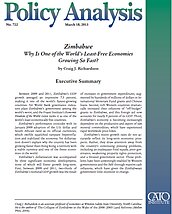Between 2009 and 2011, Zimbabwe’s GDP growth averaged an impressive 7.3 percent, making it one of the world’s fastest-growing countries. Yet World Bank governance indicators place Zimbabwe’s government among the world’s worst, and the Fraser Institute’s Economic Freedom of the World index ranks it as one of the world’s least economically free countries.
Zimbabwe’s performance coincides with its January 2009 adoption of the U.S. dollar and South African rand as its official currencies, which swiftly squelched rampant hyperinflation and stabilized the economy. Yet dollarization doesn’t explain why the country has been growing faster than Hong Kong, a territory with a stable currency and one of the freest economies in the world.
Zimbabwe’s dollarization was accompanied by three significant economic developments, none of which will foster growth long-term. First, between 2009 and 2011, two-thirds of Zimbabwe’s nominal GDP growth was the result of increases in government expenditures, augmented by hundreds of millions of dollars in International Monetary Fund grants and Chinese loans. Second, rich Western countries dramatically increased their infusions of “off-budget” grants to Zimbabwe, and this foreign aid now accounts for nearly 9 percent of its GDP. Third, Zimbabwe’s economy is becoming increasingly dependent on the production and export of raw mineral commodities, which have experienced rapid worldwide price hikes.
Zimbabwe’s recent growth rates do not accurately reflect its long-term economic prospects. Rather, they draw attention away from the country’s continuing pressing problems, including an inadequate food supply, poor governance, weakening property rights protection, and a bloated government sector. Those problems have been unwittingly enabled by Western governments and the IMF through massive cash infusions, which have given the Zimbabwean government little incentive to change.

This work is licensed under a Creative Commons Attribution-NonCommercial-ShareAlike 4.0 International License.
